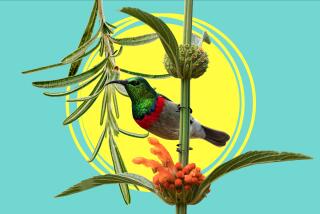Pick Your Fig
- Share via
Choosing which fig to grow can be dismaying, what with so many elements to consider in the fruit and tree. Let’s lay them out. If you can grow several trees, check with a local nursery for maturing dates of cultivars in your area so you can pick fruit from June through December. Pasquale, for instance, without frost, ripens into December.
I don’t believe in giving garden space to foods I can buy. That’s why the list below includes some outstanding figs you’ve probably never seen or tasted but not the commercial favorites: Black Mission, Brown Turkey and Kadota. I must hastily add that there are those who believe that Black Mission, planted by Junipero Serra’s padres in San Diego in 1769, is peerless for its quality of fruit, rich flavor, drying characteristics and generous crops. Black Mission grows well everywhere in Southern California but the high desert. Greenish-skinned Kadota, praised by ancient Romans, will grow in very hot climates.
Probably the most unusual fig is called Panache, a very old cultivar. Its fruit is yellow and green striped with strawberry-rose flesh. Even the branches are somewhat variegated. For flavor, I’m crazy about Jelly--the translucent flesh resembles apple jelly because it’s almost seedless. Speaking of preserves, the ruby red pulp of Ventura tastes wonderfully of strawberry jam.
All figs listed have from fine to superb flavor except Panache, which is most dazzling visually. All dry well except Genoa, Magnolia and Panache; Celeste often dries on the tree. All not included in a climate category thrive in the long warm Mediterranean-like summer areas of Southern California. All bear two crops except Desert King, Panache and Ventura.
I discovered many of these figs at the Fig Ranch. There, on a bluff in Malibu, Alice Cunningham and her late husband, George, developed an impressive collection. With good weather, their trees will continue bearing through October. Go and taste for yourself, but time your visit to miss the crowds so you can talk figs with a fascinating lady.
* Note : A number of fig cultivars have amassed aliases. One source’s Adriatic is another’s Verdone Adriatic--or Strawberry Fig. More a.k.a.s: Black Mission/Franciscan, Celeste/Blue Celeste/Sugar, Green Ischia/Verte, Jelly/Mary Lane, Negronne/Violette de Bordeaux, Panache/Striped Tiger, Pasquale/Vernino, Ventura/Strawberry.
* Coastal climates: Adriatic, Genoa, Negronne.
* Colder, wetter climates: Desert King.
* Desert climates: Conadria.
* Especially hardy: Celeste, Magnolia, Negronne, Ventura.
* Short summers: Magnolia.
* Bear especially heavily: Conadria, Green Ischia, Negronne, Pasquale.
* Especially suited to containers: Excell, Green Ischia, Jelly, Negronne.
* Fruit birds ignore: Green Ischia.
* Large fruit: Adriatic, Desert King, Magnolia, Ventura.
* Fruit for preserving: Adriatic, Magnolia.
* Fruit resists splitting: Excell.
* Fruit resists spoiling: Celeste, Conadria, Green Ischia.
* Nearly seedless fruit: Jelly, Magnolia.
Sources
Fresh: the Fig Ranch, 29127 Pacific Coast Highway, Malibu, and at farmers markets.
In five- and 15-gallon containers: Black Mission, Celeste, Conadria, Panache from Pacific Tree Farms, 4301 Lynwood Drive, Chula Vista, CA 91910.
Adriatic, Excell, Jelly, Pasquale, Ventura from Exotica Rare Fruit Nursery, P.O. Box 160, Vista, CA 92083.
Desert King, Kadota, Negronne from Burnt Ridge Nursery, 432 Burnt Ridge Road, Onalaska, WA 98570.
Green Ischia, Magnolia from Oregon Exotics Rare Fruit Nursery, 1065 Messinger Road, Grants Pass, OR 97527. Shipping Oct. 15 to Nov. 30 and January to April 15.
Genoa from Sonoma Antique Apple Nursery, 4395 Westside Road, Healdsburg, CA 95448.
Tree scare balloons from any local nursery that stocks fruit trees.






